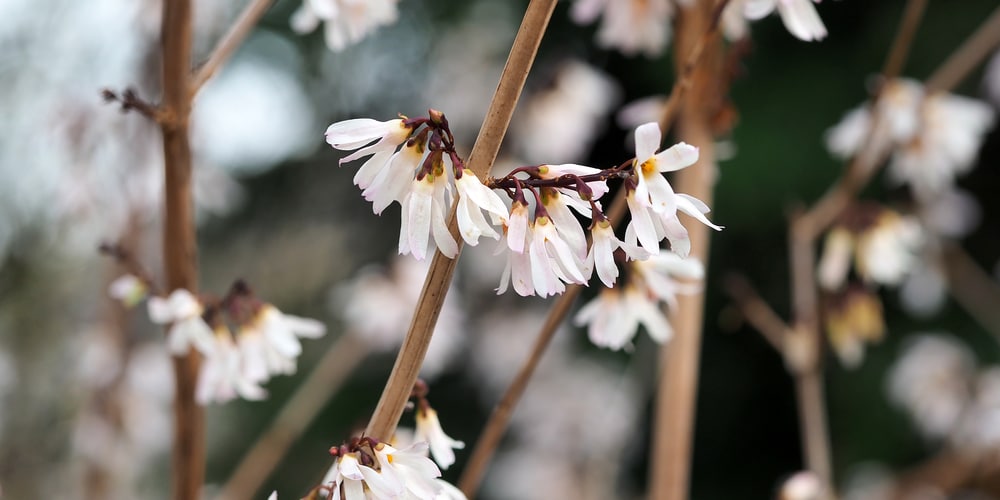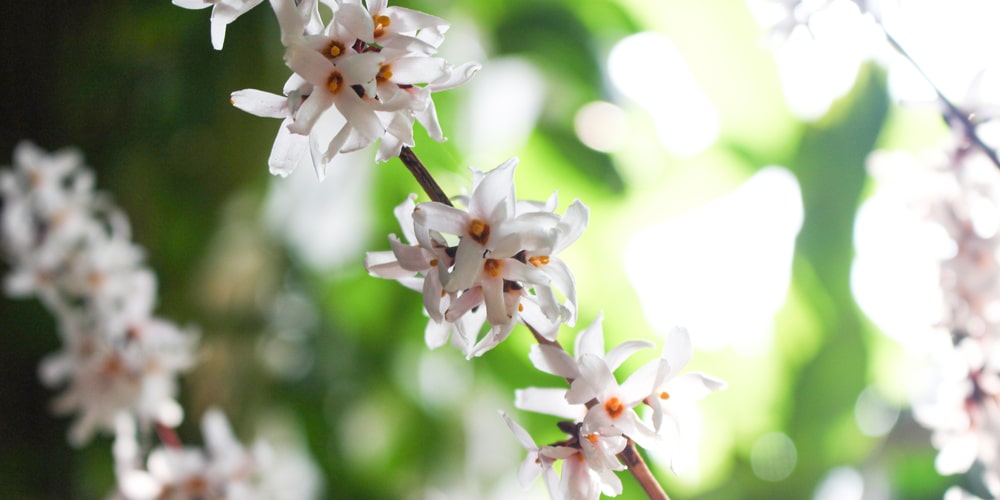A small shrub with an arching habit and rounded form, the White Forsythia produces early spring blooms to welcome warmer seasons. The plant is related to Forsythia with a notable distinction of having white flowers instead of yellow.

| Botanical Name | Abeliophyllum distichum |
| Common Name | White Forsythia |
| Plant Type | Perennial or Annual |
| Flower Color | Small, four-petaled white flowers with an almond scent |
| Size When Mature | 72 inches |
| Bloom Time | Early Spring |
| Sun Requirements | Full sun to part shade |
| USDA Hardiness Zones | 5 to 9 |
| Soil PH Range | Neutral, Acidic, Alkaline |
| Soil Type | Moist, well-drained |
| Water Needs | Medium |
| Native Area | Korea |
What you Need to Know About White Forsythia
White Forsythia is native to Korea and looks spectacular in early spring. After blooming, the shrub begins producing green and glossy leaves that are similar to the Abelia species.
The small white flowers will remind you of almonds when it comes out on display. White Forsythia is quite hardy but it does require regular pruning for bushier growth and more blooms.
White Forsythia Care Tips
Here’s everything you need to know about growing and caring for a thriving White Forsythia.
Light
Abeliophyllum distichum can reach its full size of 5 feet in length and 4 feet spread if it grows in locations that get full sunlight. White Forsythia will also accept being placed in partial shade although its growth will not be as vigorous.
White Forsythia is best planted as a screen or hedge, in the front yard, or as a foundational landscape piece. The deciduous shrub loses all its dark green foliage when winter arrives but grows them back as soon as it completes a flower show.
Water and Soil Needs
The White Forsythia isn’t particular about the soil pH or type, but it does have an issue with drought conditions. The medium should be well-drained and contain plenty of nutrients, preferably organic matter.
The only care you need to give a White Forsythia is to remember to water the plant well and keep the soil moist. During its first year and while getting established you shouldn’t allow the soil to completely dry out or it will stunt the forsythia’s growth.
Temperature Requirements
White Forsythia grows in zones 5 to 9 and can tolerate cold and winter conditions well. In colder climates, you can add a thick layer of mulch to protect the roots and keep the soil from drying out.
It’s normal for White Forsythia to start shedding its leaves in preparation for winter. The shrub should come out of dormancy as long as there’s no extended hard frost and will grow new leaves and stems in the process.
Fertilizer
The best fertilizer to use on a White Forsythia is a balanced mix.
Forsythias can benefit from summer feedings of granular or liquid fertilizers at a 20-20-20 or 20-30-20 ratio. Alternatively, you can apply organic matter such as manure every month or so to encourage more foliage and healthier growth.
Aside from giving fertilizer, it’s recommended that you regularly prune White Forsythias and cut the stems back near last year’s growth to get more blooms. Remember to clean up debris and any dead leaves or stems to keep the shrub looking its best.
Common Diseases
The White Forsythia may be affected by several diseases, such as leaf spot, galls, twig blight, and root rot.
Galls appear as knobs in the stems and serve to weaken your forsythia as time goes on. The exact reason is unclear but you can usually fix this by removing the affected stem. Black or brown spots on leaves may signal leaf spot, which can be removed using fungicide. Maintaining good airflow between the stems and watering only when the soil is a bit dry can prevent leaf spots from occurring.
Twig blight is caused by excessive moisture and appears as a white covering on the stems. Finally, root rot is the effect of having constantly waterlogged soil, and the only solution is to dispose of your white forsythia and start over.
White Forsythia Propagation
You can try to get more White Forsythia plants for your yard or garden through stem cuttings.
Cut semi-hardwood stems from late summer to fall using a sharp knife. Remove the lower leaves and place them in a pot with a compost medium. Moisten well and put the container where it gets bright light, then wait for new growth to appear (which can take several weeks).
Related article: Do Bees Like Forsythia?
